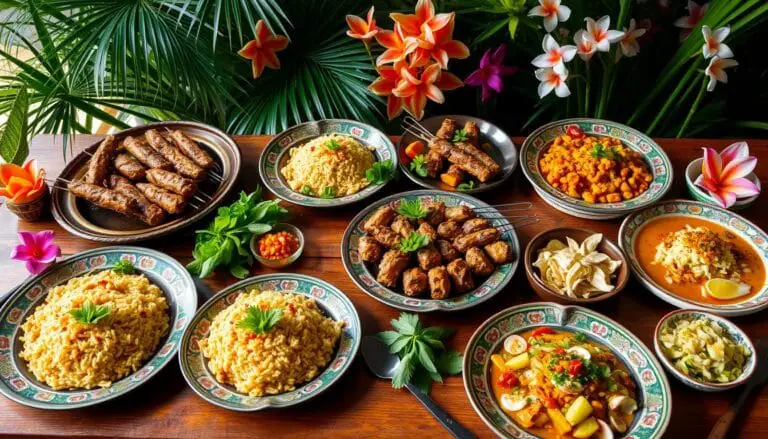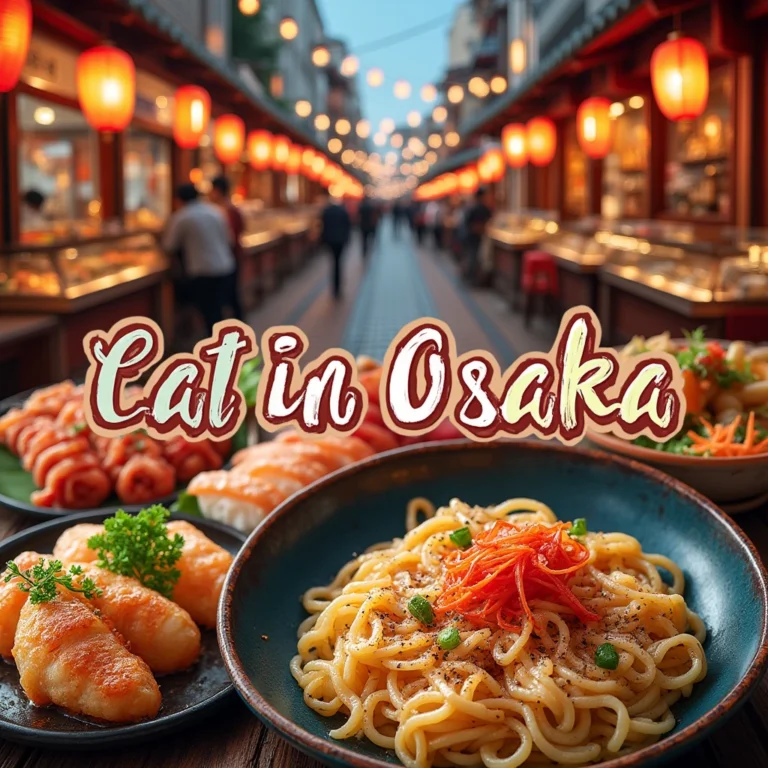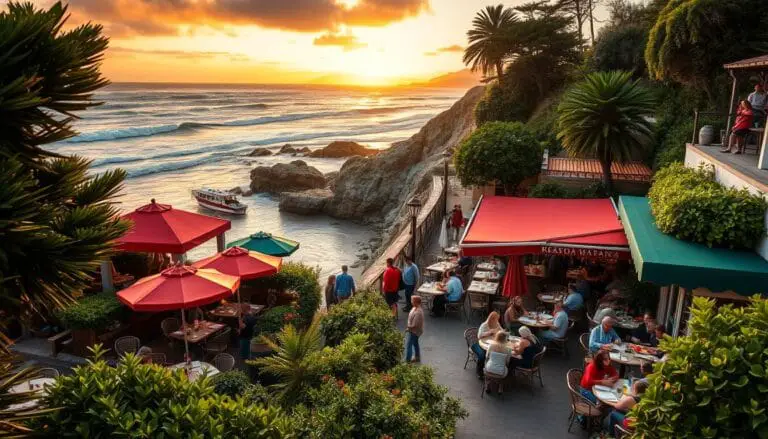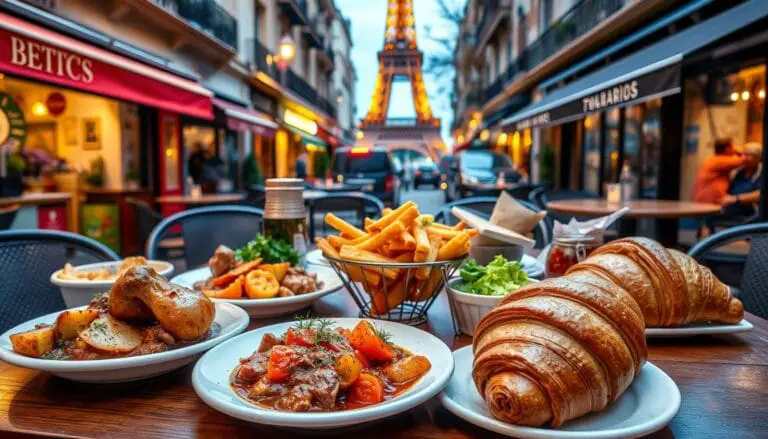Exploring the Cuisine of Quebec: A Guide to Authentic Flavors
This site contains affiliate links . At no additional cost to you, I may receive a commission off these links. They help fund this blog. Thanks for your support! See my Disclosure Policy for more info.
Growing up, I always dreamed of exploring food traditions. Quebec’s cuisine, with its rich flavors, has always caught my eye. It’s more than just food; it’s a story of culture and heritage.
Quebec’s food scene is a journey through history. It mixes French elegance, Indigenous wisdom, and modern twists. From Montreal’s busy streets to the quiet farms, Quebec’s dishes tell a unique story.
This guide will show you the heart of Quebec’s cuisine. You’ll see its cultural roots and innovative spirit. Get ready to explore the flavors that make Quebec special.
Table of Contents
The Historical Evolution of Quebec’s Food Heritage
Quebec’s food journey is a mix of many cultures. It started with indigenous knowledge, French traditions, and later, multicultural influences. These changes shaped how people cooked over the years.
The story of French Canadian food began in the 1600s with French settlers. They brought their cooking ways and learned from the Algonquins and Iroquois.
French Colonial Culinary Foundations
During the colonial times, French settlers used local ingredients in their cooking. They learned important skills like:
- Maple syrup harvesting techniques
- Meat preservation methods
- Ice fishing practices
- Wild game hunting strategies
British and American Culinary Contributions
The British takeover brought new foods and cooking styles. Potatoes became a key ingredient. American dishes like baked beans and ketchup also made their way into Quebec’s food scene.
Modern Cultural Transformations
The 20th century saw big changes in Quebec’s food world. New dishes like poutine emerged, showing the province’s evolving food identity.
Quebec’s cuisine tells a story of survival, adaptation, and cultural celebration through food.
Now, Quebec focuses on local foods, sustainability, and local chefs. This continues its exciting food journey.
Understanding the Cuisine of Quebec
Quebec’s food scene is a mix of history and local flavors. It combines French, Indigenous, and British cooking styles. This blend creates a unique taste experience.
The focus on local ingredients is key to Quebec’s food culture. Farmers and artisans help make dishes that show off the area’s cultural mix.
Food is our cultural identity on a plate – Quebec Chef Perspective
- French-inspired cooking techniques
- Indigenous ingredient integration
- Seasonal farm-to-table approach
Quebec’s food is known for its special qualities:
| Culinary Element | Unique Feature |
|---|---|
| Maple Syrup | World’s largest producer (80% global production) |
| Cheese Production | Over 700 varieties of high-quality cheeses |
| Local Ingredients | Wild berries, game meats, seasonal produce |
Exploring Quebec’s food scene, you’ll find dishes that tell stories of survival and cultural mix. Quebec’s food journey is a taste of its history, with maple syrup and game meats leading the way.
The Art of Poutine: Quebec’s Signature Dish
Poutine is the star of Quebec’s dishes, loved by many in Canada and worldwide. It started as a simple comfort food in rural Quebec. Now, it’s a national treasure.
Poutine is all about hearty, simple, and flavorful food. It’s made with crispy fries, cheese curds, and brown gravy. This mix shows Quebec’s love for good food and pride in its traditions.
Traditional Preparation Methods
Making perfect poutine needs care and respect for old ways. The main parts are:
- Fresh, hand-cut french fries
- Local cheese curds at room temperature
- Savory, thick brown gravy
- Precise layering technique
Popular Poutine Variations
Quebec’s chefs love to try new things with poutine. Here are some tasty twists:
| Variation | Key Ingredients |
|---|---|
| Classic Poutine | Fries, cheese curds, gravy |
| Smoked Meat Poutine | Added Montreal-style smoked meat |
| Vegetarian Poutine | Vegetable gravy, plant-based cheese |
Best Places to Try Authentic Poutine
Exploring Quebec’s food scene means trying poutine at these famous spots:
- La Banquise (Montreal) – Offers over 30 varieties
- Chez Aston – Known for classic preparations
- Poutineville – Custom poutine creation
Poutine isn’t just a dish; it’s a cultural experience that defines Quebec’s culinary spirit. – Local Food Critic
Poutine’s journey from humble beginnings to national favorite shows Quebec’s love for food. Whether you’re new or a seasoned food lover, poutine offers a unique taste adventure.
Traditional Meat Dishes and Tourtière
Quebec’s cuisine is famous for its hearty dishes that share stories of culture. At the center of these traditions is the tourtière, a meat pie loved by families for ages.
The tourtière has been around since the 1600s. It’s more than a meal; it’s a treasured part of Quebec’s food history. This pie is filled with spiced meats in a flaky pastry. Its special spice mix makes it unique:
- Cinnamon
- Clove
- Allspice
- Nutmeg
Each region in Quebec has its own twist on the tourtière. In Montreal, it’s made with ground pork, beef, or veal. But in the Saguenay-Lac St. Jean area, they use game meats. Some even add seafood like salmon or trout.
A slice of tourtière is like a taste of Quebec’s culinary history – Traditional Quebec Chef
But finding tourtière in restaurants is rare. It’s because making it is so complex. Most families keep their recipes alive, serving it at Christmas and the réveillon feast.
| Region | Tourtière Characteristic |
|---|---|
| Montreal | Ground meat pies |
| Saguenay-Lac St. Jean | Game meat chunks |
| Maritime Provinces | Known as Pâté à la Viande |
For food lovers or history fans, tourtière is a must-try. It’s a taste of Quebec’s rich food culture. Every bite brings the warmth of tradition and Quebec’s diverse heritage.
Maple Syrup Culture and Sugar Shacks
Quebec is the world’s top maple syrup producer, making 92% of Canada’s and 72% of the world’s. It’s more than a sweetener; it’s a key part of Quebec’s culture and farming history.
Maple syrup magic starts with a big change. It takes 40 liters of maple water to make 1 liter of syrup. Quebec’s 13,000 maple producers make almost 96 million kilograms of syrup each year. Almost half of it is organic.
Seasonal Harvesting Traditions
The sugaring off season is from late February to early May. During this time, sugar shacks buzz with old maple harvesting ways:
- Tree tapping with traditional methods
- Collecting maple water in wooden buckets
- Boiling sap over wood fires
- Watching syrup color and flavor
Popular Maple-Based Dishes
Quebec loves maple in many tasty dishes. You’ll find:
- Maple taffy on snow
- Grands-pères (maple dumplings)
- Maple-glazed meats
- Sugar pie
Visiting Quebec’s Sugar Shacks
Sugar shacks are great for those who love food culture. Places like Érablière du Cap and Cité Agricole offer:
- Maple syrup making demos
- Gourmet maple meals
- Horse-drawn sleigh rides
- Maple museums
Maple syrup is not just a food, it’s a celebration of Quebec’s rich agricultural heritage.
Exploring Quebec’s maple syrup culture is a sweet adventure. It’s perfect for food lovers and curious travelers alike.
Montreal’s Famous Bagels and Jewish Influences
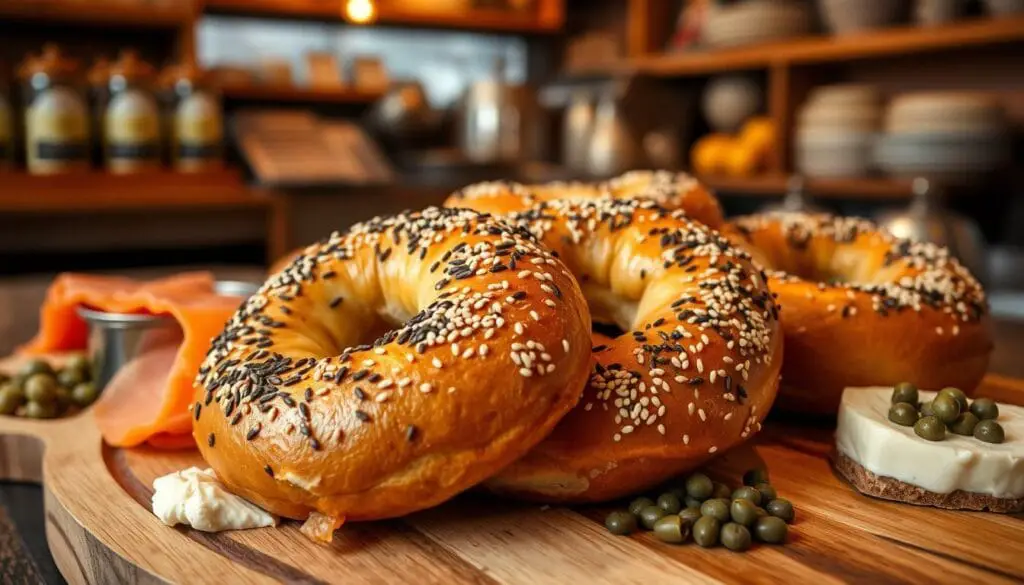
Montreal’s bagels are a special treat in the world of quebec food. They were brought by Ashkenazi Jewish immigrants to the Mile End neighborhood. These bagels are smaller, denser, and sweeter than others, thanks to being boiled in honey water.
In Montreal, a bagel is not just bread – it’s a cultural statement. – Local Food Historian
The Jewish influence in Quebec goes beyond just bagels. Two famous bakeries are key to this:
- St-Viateur Bagel: A Mile End institution since 1957
- Fairmount Bagel: The neighborhood’s rival bakery
The Jewish community also made a big mark on Quebec’s food. Montreal Smoked Meat is a big part of this. Places like Schwartz’s Hebrew Delicatessen are famous for their sandwiches. They mix Eastern European methods with local tastes.
Looking into these traditions shows Montreal’s diverse food heritage. From wood-fired ovens to special sandwiches, Jewish influence is clear. It helps make Quebec’s food scene unique.
Iconic Quebec Desserts and Sweet Treats
Quebec’s food scene is rich with sweet treats that highlight the region’s traditions. These desserts tell stories of culture, resourcefulness, and the maple syrup industry. They are key to Quebec’s gastronomy.
Pouding Chômeur: A Depression-Era Delicacy
Pouding chômeur (unemployed man’s pudding) was born in the Great Depression. It shows Quebec’s creativity in cooking. Made in the 1920s, it uses simple ingredients.
The recipe mixes a cake batter with a maple syrup sauce. It’s a symbol of Quebec’s culinary spirit.
- Originated in 1929 during economic hardship
- Uses pure maple syrup as a key ingredient
- Symbolizes resilience of Quebecois cuisine
Tarte au Sucre: The Traditional Sugar Pie
Tarte au sucre is a beloved Quebecois specialty. It shows the region’s love for sweet flavors. The pie has a caramelized filling made from maple syrup or brown sugar.
It’s in a flaky pastry crust. This pie is a must-try for anyone visiting Quebec.
| Ingredient | Quantity |
|---|---|
| Maple Syrup | 1 ½ cups |
| Heavy Cream | 1 ½ cups |
| All-Purpose Flour | 1 ½ cups |
Maple Taffy: A Unique Canadian Tradition
Maple taffy is a must-try in Quebec. It’s made by pouring hot maple syrup onto snow. This creates a sweet, sticky treat that shows Quebec’s maple culture.
Maple syrup is not just a condiment, it’s a cultural symbol of Quebec. – Local Chef
These desserts are more than just treats. They show Quebec’s creativity in cooking. They highlight how simple ingredients can create amazing experiences.
Seafood and Coastal Specialties
Quebec’s long coastline along the St. Lawrence River is home to a lively seafood culture. This culture is a big part of the regional cuisine of Quebec. The province’s waters offer a wide variety of fresh seafood specialties.
The coastal areas of Quebec are famous for their seafood traditions. Fishing communities have created special cooking methods. These methods turn simple ingredients into amazing dishes. From the Gaspé Peninsula to Quebec City, seafood is a big part of the local food scene.
The sea is our garden, and every catch tells a story of our heritage. – Quebec Fisherman’s Saying
- Salmon from the St. Lawrence River
- Atlantic cod from coastal waters
- Lobster and mussels from maritime regions
- Fresh shellfish harvested locally
In Montreal and Quebec City, seafood is treated like art. Chefs mix old quebecois cooking with new ideas. They make dishes that show off the natural taste of local seafood.
| Seafood Specialty | Region of Origin | Typical Preparation |
|---|---|---|
| St. Lawrence Salmon | Gaspé Peninsula | Grilled or poached with local herbs |
| Atlantic Cod | Coastal Quebec | Salt-cured or fresh baked |
| Lobster | Maritime Regions | Steamed with butter |
Exploring quebec food, you find that seafood is more than a meal. It’s a way to connect with Quebec’s rich maritime history. Each dish shares stories of local traditions, sustainable fishing, and the bond between Quebec’s people and their waters.
Farm-to-Table Movement in Quebec

Quebec’s food scene has changed a lot with the farm-to-table movement. This new way of cooking focuses on using local ingredients and supporting local farmers. It brings people closer to the food they eat, celebrating Quebec’s rich food traditions.
Local Ingredients and Sustainability
The farm-to-table idea in Quebec is more than just using local food. It’s about:
- Lowering carbon emissions
- Helping local farmers
- Keeping Quebec’s food traditions alive
- Ensuring food is fresh and of high quality
Our food tells a story of our land, our people, and our traditions. – Quebec Chef
Supporting Regional Producers
Restaurants in Quebec are now working closely with local farmers. Places like Vin Mon Lapin are known for their dedication to local food. They show how Quebec’s food traditions can grow while staying true to local roots.
Restaurants are finding new ways to help local farming:
- Joining community-supported agriculture (CSA) programs
- Building direct relationships with farmers
- Creating menus that change with the seasons
- Using cooking methods that waste nothing
The farm-to-table movement in Quebec shows how food innovation can protect cultural heritage. It also promotes sustainable practices.
Quebec’s Artisanal Cheese and Wine Culture
Explore the rich world of Quebec’s gastronomy, where cheese and wine come together in a unique way. The province is home to over 500 cheese varieties. Each one tells a story of local tradition and skill.
Quebec’s cheese scene is truly remarkable. In 2023, over 25 Québec cheeses won international awards. Some must-try specialties include:
- Oka – A creamy, distinctive cheese with deep cultural roots
- Riopelle – A soft, rich cheese named after a famous Quebec artist
- Various award-winning cheddar varieties
Quebec’s cuisine goes beyond cheese to a vibrant wine culture. With over 100 wineries, the Eastern Townships and Montérégie regions are a haven for wine lovers. The 165-kilometre wine route offers nine unique activities to discover local wines.
Quebec’s wine and cheese are more than food – they’re a celebration of our cultural heritage. – Local Artisan Cheesemaker
Some exciting wine experiences include:
- La Bullerie – Quebec’s first sparkling wine specialist
- Domaine Vineterra – Featuring 25,000 vine plants
- Le Chat Botté – An organic vineyard in Quebec’s warmest region
Whether you love food or exploring culture, Quebec’s cheese and wine scene is a journey you won’t forget.
Modern Interpretations of Traditional Quebec Cuisine
Quebec’s food scene is changing fast. Chefs are making old recipes new again with modern methods and global flavors.
Today, chefs mix creativity with tradition. They use local ingredients in new and exciting ways. This is happening in restaurants all over Quebec.
We’re not just preserving our culinary heritage – we’re reinventing it, says Chef Marie Tremblay, a leading figure in Quebec’s modern cuisine movement.
- Gourmet poutine with artisanal cheese and truffle oil
- Deconstructed tourtière with modern plating techniques
- Farm-to-table interpretations of classic dishes
- Molecular gastronomy meets traditional Quebec recipes
Local chefs are mixing international styles with Quebec’s unique flavors. This is true in both big cities and small towns. They’re turning old dishes into modern art.
| Traditional Dish | Modern Interpretation |
|---|---|
| Cipâte | Layered meat terrine with exotic spices |
| Pouding Chômeur | Deconstructed maple dessert with molecular techniques |
| Cretons | Refined pâté with gourmet ingredient pairings |
This new wave in Quebec’s food scene is a big deal. It’s making Quebec’s food culture even more exciting. Chefs are keeping traditions alive while bringing in fresh ideas.
Conclusion
The cuisine of Quebec is more than just food. It’s a story of culture and innovation. Exploring Quebecois cuisine, you find a mix of French, indigenous, and multicultural influences. This creates a unique taste experience in North America.
Quebec food shows the province’s love for tradition and new ideas. It’s famous for maple syrup and dishes like poutine and tourtière. These foods tell a story of creativity and cultural pride.
Reflecting on Quebec’s flavors and traditions, you see a region that values its ingredients and traditions. Quebec’s cuisine is a blend of history and new ideas. It invites food lovers to a unique and authentic culinary journey.
In Quebec, you can enjoy artisanal cheeses, farm-to-table meals, and culinary festivals. It’s a place where food traditions are a key part of understanding its culture.
Check Out This Article : Plan the Ultimate Montreal Getaway: How Many Days to Stay?
FAQ
What makes Quebec cuisine unique?
Quebec’s food is a mix of French, Indigenous, and British tastes. It uses local items like maple syrup, game, and wild berries. The dishes are hearty and warm, showing the province’s culture and climate.
What is the most famous dish from Quebec?
Poutine is Quebec’s star dish. It’s french fries with cheese curds and brown gravy. It started in the 1950s and now has many variations.
What is tourtière and when is it typically served?
Tourtière is a meat pie eaten during holidays. It’s made with minced meats and spices in a flaky crust. Coastal areas use fish like salmon, and it’s often served with sweet toppings.
Why is maple syrup so important to Quebec?
Quebec makes most of the world’s maple syrup. Sugar shacks are key in making it. They offer special experiences and dishes like maple taffy.
What are Montreal-style bagels?
Montreal bagels are small and dense. They’re baked in wood-fired ovens and taste sweeter. Places like Fairmount Bagel are famous for them.
How has Quebec’s cuisine evolved in recent years?
Quebec’s food now mixes old recipes with new techniques and flavors. Chefs use local ingredients and keep the province’s food traditions alive.
What role does seafood play in Quebec cuisine?
Quebec’s long coast offers a lot of seafood. Places along the St. Lawrence River serve dishes like salmon and mussels. They mix old cooking ways with new.
What desserts are traditional in Quebec?
Quebec has desserts like pouding chômeur and tarte au sucre. They often use maple syrup, showing the province’s love for sweet treats.
How important is the farm-to-table movement in Quebec?
The farm-to-table movement is big in Quebec. Restaurants support local farmers and use ingredients from nearby. They focus on fresh, organic food and help the local economy.
What is unique about Quebec’s cheese and wine culture?
Quebec has a strong cheese and wine scene. Cheeses like Oka are famous, and the wine industry is growing. The wines and ciders show off the local flavors.



